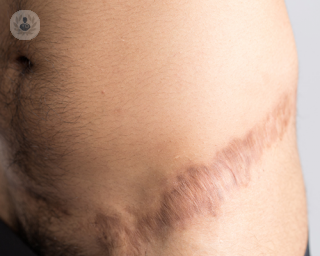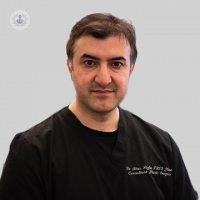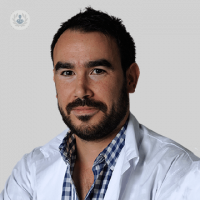What are scars?
Scars are marks left on the skin after a wound or injury has healed. Visible scars remain on the skin when the deeper layers of your skin have been injured. Many minor lesions, such as lacerations, cuts, abrasions or burns, will not leave a scar.

How does scarring happen?
After a lesion or injury, the healing process consists of three phases: inflammation, proliferation and maturation.
- The inflammatory phase takes place 48-72 hours right after a wound is made. The wound starts closing on its own with a blood clot and the new tissue starts growing.
- In the following three to six weeks, during the proliferative phase, the connective tissue builds up to close the wound.
- During the maturation phase, which can last a few months or a few years in the most severe cases, the deepest layers of the epidermis keep on repairing themselves in a process called 'remodelling'.
What influences the scar formation process?
Scar healing is a highly individual process which can be influenced by several factors, and not only the size and depth of a wound.
For instance, your age is important; the older you are, the longer the wound healing process takes. However, if you are in the age range of 10 to 30 years, an overproduction of connective tissue can compromise the wound healing process.
Furthermore, people with a really pale or darker skin type may have more obvious scars, as well as people suffering from a hormone imbalance, such as teenagers and pregnant women. The scar formation process is also influenced by the location of the wound: scars tend to form in parts of the body where the skin is less mobile, like the upper chest and back. These areas are also more prone to an overgrowth of scar tissue leading to thick 'hypertrophic' scars and keloids.
Should there be any complications after a wound, such as an infection, the risk of getting a less cosmetically pleasing scar will be much higher.
Types of scars:
Scars can be divided into hypertrophic scars, keloid scars and atrophic scars.
- Keloid and hypertrophic scars are mainly caused by an overproduction of connective tissue, which makes the scar grow outside of the original wound area. Keloid scars are much bigger than the original wound size and tend to be more invasive and persistent than hypertrophic scars. They tend to grow in areas where the skin is tense. People with a genetic predisposition and people with darker skin types are more prone to these types of scars.
- Atrophic scars or pitted scars are caused by a lack of collagen in the wounded area, creating a sunken recess on the skin. They are particularly common in individuals with acne or chickenpox.
Scars
Dr Marisa Taylor - Dermatology
Created on: 10-26-2015
Updated on: 05-09-2023
Edited by: Sophie Kennedy
What are scars?
Scars are marks left on the skin after a wound or injury has healed. Visible scars remain on the skin when the deeper layers of your skin have been injured. Many minor lesions, such as lacerations, cuts, abrasions or burns, will not leave a scar.

How does scarring happen?
After a lesion or injury, the healing process consists of three phases: inflammation, proliferation and maturation.
- The inflammatory phase takes place 48-72 hours right after a wound is made. The wound starts closing on its own with a blood clot and the new tissue starts growing.
- In the following three to six weeks, during the proliferative phase, the connective tissue builds up to close the wound.
- During the maturation phase, which can last a few months or a few years in the most severe cases, the deepest layers of the epidermis keep on repairing themselves in a process called 'remodelling'.
What influences the scar formation process?
Scar healing is a highly individual process which can be influenced by several factors, and not only the size and depth of a wound.
For instance, your age is important; the older you are, the longer the wound healing process takes. However, if you are in the age range of 10 to 30 years, an overproduction of connective tissue can compromise the wound healing process.
Furthermore, people with a really pale or darker skin type may have more obvious scars, as well as people suffering from a hormone imbalance, such as teenagers and pregnant women. The scar formation process is also influenced by the location of the wound: scars tend to form in parts of the body where the skin is less mobile, like the upper chest and back. These areas are also more prone to an overgrowth of scar tissue leading to thick 'hypertrophic' scars and keloids.
Should there be any complications after a wound, such as an infection, the risk of getting a less cosmetically pleasing scar will be much higher.
Types of scars:
Scars can be divided into hypertrophic scars, keloid scars and atrophic scars.
- Keloid and hypertrophic scars are mainly caused by an overproduction of connective tissue, which makes the scar grow outside of the original wound area. Keloid scars are much bigger than the original wound size and tend to be more invasive and persistent than hypertrophic scars. They tend to grow in areas where the skin is tense. People with a genetic predisposition and people with darker skin types are more prone to these types of scars.
- Atrophic scars or pitted scars are caused by a lack of collagen in the wounded area, creating a sunken recess on the skin. They are particularly common in individuals with acne or chickenpox.


Keloid scars: What are my treatment options?
By Dr Richard Shaffer
2024-12-15
Keloid scars can go deep into the skin, causing some people to feel self-conscious and searching to find the best solution to improve their appearance. Leading specialist in radiotherapy and non-cancer conditions Dr Richard Shaffer explains what they are and what the treatment options are available. See more


How to treat acne scars
By Dr Hiba Injibar
2024-12-15
When experiencing acne, it can feel like a struggle to feel good about ourselves. Luckily, with the help of Dr Hiba Injibar, the effects of acne on both our skin and mental health can be minimised. With her impressive repertoire in dermatology, Dr Injibar offers comprehensive care for treating the root cause of acne and also the more persistent symptoms that include scarring. Find out how acne scarring can be avoided, why it sometimes occurs, and what the treatment options are for smoother skin, in this latest Q&A. See more


Scar treatment: how to get rid of prominent scarring
By Mr Paul Tulley
2024-12-14
Injuries and surgery can leave prominent scars, which can bother people for years to come. Depending on where the scar is, it may cause distress or embarrassment over their physical appearance. The most common reason for prominent scars is that the skin has not healed properly. Is there a solution? Esteemed plastic surgeon Mr Paul Tulley has the answers. See more


Scar healing: ask an expert
By Mr Rob Winterton
2024-12-14
Operations leave scars and plastic surgery is no exception. Many patients may worry about going under the knife because of the marks they could be left with. How long does it take scars to settle and how can you look after them and help them to heal? We asked expert plastic surgeon Mr Rob Winterton our biggest questions about scar healing. See more
Experts in Scars
-
Dr Saqib Jawaid Bashir
DermatologyExpert in:
- Mohs surgery
- Cosmetic dermatology
- Laser
- Skin cancer
- Scars
- Acne
-
Mr Alastair MacKenzie Ross
Plastic surgeryExpert in:
- Melanoma
- Electrochemotherapy
- Keloid scars
- Scars
- Surgical oncology
- Skin cancer
-
Mr Nicholas Parkhouse
Plastic surgeryExpert in:
- Scars
- Moles
- Skin cancer
- Facelift
- Breast reduction
- Tummy tuck (abdominoplasty)
-
Mr Riaz Agha
Plastic surgeryExpert in:
- Scars
- Septorhinoplasty
- Tummy tuck (abdominoplasty)
- Breast augmentation
- Liposuction
- Blepharoplasty
-
Mr George Christopoulos
Plastic surgeryExpert in:
- Blepharoplasty
- Breast augmentation
- Dark circles
- Liposuction
- Tummy tuck (abdominoplasty)
- Scars
- See all

The Sloane Hospital - part of Circle Health Group
The Sloane Hospital - part of Circle Health Group
125 Albemarle Rd, Beckenham BR3 5HS
No existe teléfono en el centro.
By using the telephone number provided by TOP DOCTORS, you automatically agree to let us use your phone number for statistical and commercial purposes. For further information, read our Privacy Policy
Top Doctors

Yorkshire Skin Centre
Yorkshire Skin Centre
1 Sizers Court, Yeadon
No existe teléfono en el centro.
By using the telephone number provided by TOP DOCTORS, you automatically agree to let us use your phone number for statistical and commercial purposes. For further information, read our Privacy Policy
Top Doctors
-
The Sloane Hospital - part of Circle Health Group
125 Albemarle Rd, Beckenham BR3 5HS , South LondonExpert in:
- Abdominal ultrasound
- Vascular Surgery
- Cardiology
- Colorectal surgery
- Endocrine Surgery
- General Surgery
-
Yorkshire Skin Centre
1 Sizers Court, Yeadon, LeedsExpert in:
- Dermatology
- Clinical Dermatology
- Cosmetic Dermatology
- Facial aesthetics
- See all
- Most viewed diseases, medical tests, and treatments
- Facial feminisation surgery
- Hormone therapy
- Migraine
- Autoimmune diseases
- Nutrition
- Weight loss injections
- Endermologie
- Polynucleotides
- Endovenous laser treatment (EVLA)
- Head and neck cancer







